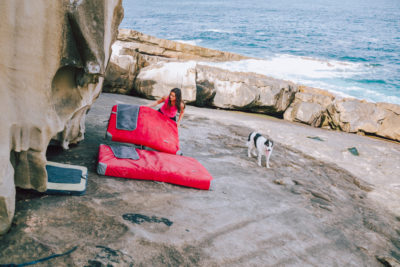There is a lot of discussion on indoor grading and how it compares to grades used on outdoor boulders. While both use the same grading system, there are, indeed, differences.
Are bouldering problems graded differently in gyms than outdoors? The same V-grade system is used both indoors and out. However, in gyms, V0 to V5/V6 problems tend to be graded soft, or easier, than the same grade on outdoor boulders. Grades higher than V7/V8 tend to be graded more equally indoors and out.
Although theoretically the grading should be the same, differences are inevitable due to limitations that apply to bouldering gyms but not to outdoor bouldering areas.
Differences between Indoor and Outdoor Boulder Grades
John Sherman’s V-scale grading system is used for both indoor and outdoor bouldering.
In theory, V grades should transfer directly across from indoors to outdoors. However, they generally do not. The difficulty of a specific V grade can vary depending on whether you are bouldering in a gym or out on a real boulder, and on the grade itself.
There seems to be a consensus that up to V5/V6, an outdoor grade will be about two V grades harder than the same grade indoors. In other words, a V3 problem would be easier in the gym and more challenging outdoors. So for a beginner, an outdoors V0 will compare to a gym V2.
However, this is not consistent over the entire grade span. The higher grades, V8 to V12, have been reported as being equal indoors and out. Or, if there is a difference, these higher grades are more challenging indoors. In other words, unlike the lower grades, a V8 problem would likely be more difficult in a gym than on a real rock wall.
Why Are There Differences in Grade Difficulty?
Unlike most outdoor bouldering areas, an indoor gym is a business that needs devoted clients. New customers who see a visible improvement within a short amount of time are motivated to continue with the sport. Gyms sometimes bump problems up a grade for this purpose. This is why lower-grade indoor problems tend to be graded “soft”.
Higher grades tend to match each other indoors and out because it is the more advanced boulderers who will be climbing on these problems. These people are much more likely to do a lot of outdoor climbing, and to have a solid grasp of outdoor grading. Gyms tend to set up their higher-graded problems more accurately for this group.
Why Indoor Competency Does Not Transfer Well to Real Rock
Adjusted V grades is not the only reason indoor problems are generally considered easier. Outdoors on real boulders, there is the rough, skin-peeling feel of actual rock, holds can be subtle and harder to spot, and there is no reassuring wall-to-wall padding to land on.
The weather can send a frigid wind that stiffens the joints, rain that makes the rock slick, or bright blazing sunshine that turns the boulder wall into a furnace. Compared to the predictable environment of a gym, these can add up to a rather intimidating experience.
On real rock, the placement of holds is infinitely variable. Footholds can be almost invisible, handholds awkwardly placed, sequences less predictable. In a gym, footholds are much larger, handholds are more grip-friendly, beta is easier to figure out.
Indoor gyms generally do not try to replicate the subtlety of outdoor problems. The materials used to make indoor holds simply do not allow exact replication. A plastic hold must be of a certain size and thickness for screws to be applied securely, so copies of very narrow crimp ledges, for example, are not found in gyms. Larger holds such as jugs are common in gyms, but very rare outside.
Real boulders require a lot more time and effort to read and puzzle through than the familiar set routes of a gym. This will often add to the challenge of an outdoor problem.
For these reasons, competency in the gym does not necessarily transfer to natural boulders. Smaller holds, more difficult footwork, almost no jugs, more wear and tear on skin, trickier reading of beta, fickle weather, and concern over landing on the pad and not beside it, will all add to the perceived difficulty of an outdoor problem.
Therefore, when bouldering outdoors for the first time, it is recommended to go with an experienced group or partner, and to start at least two grades lower than one’s usual gym grades.
Related Questions
Why is outdoor grading not consistent between different bouldering areas? It largely depends on when they were graded. Outdoor problems that were graded decades ago have a tendency to be undergraded, where the difficulty is higher than the grade that was assigned. Newer problems can have the opposite issue of soft grading, where the challenge is less than the grade would suggest.
What do I need to bring for outdoor bouldering? If the site does not have washrooms, you will need a plastic bag for feces and toilet paper. Bring drinking water, sunscreen, layered clothing, and wind-and-rain-resistant outerwear. Helmets are not used in bouldering gyms, but are important to wear outdoors due to the risk of falling rocks. You will need approach shoes and landing mats as well as climbing shoes, chalk and brush. For safety, bring a local map, a first aid kit, and a communication device in case of accident or emergency. Before leaving, check if the area has cell phone coverage.
What are some other differences between indoor and outdoor boulder problems?
- Gyms don’t set problems higher than V10 or V11, because very few clients use grades higher than this. In contrast, the highest outdoor grade, to date, is V17.
- Gym problems tend to be shorter than outdoor problems, requiring less stamina.
- A gym problem will tend to have only one way to send, while the fine variations on a real rock face usually offer more sending choices. This is an advantage for those who have a body type or size different from what is typically set for in their local gym.

